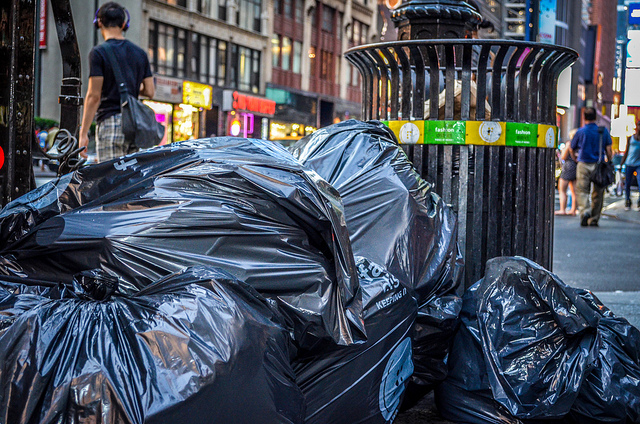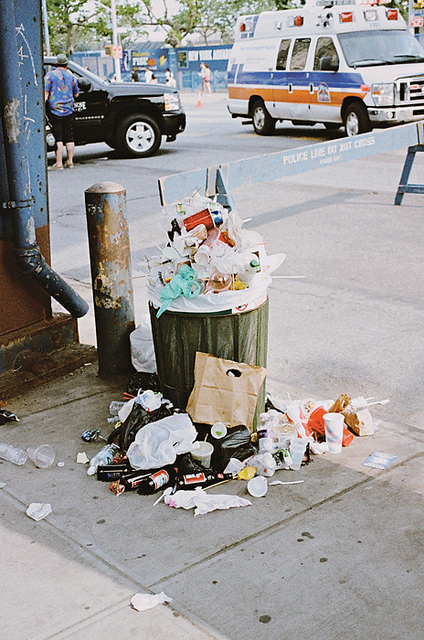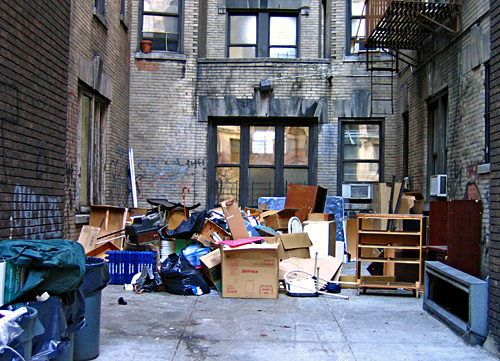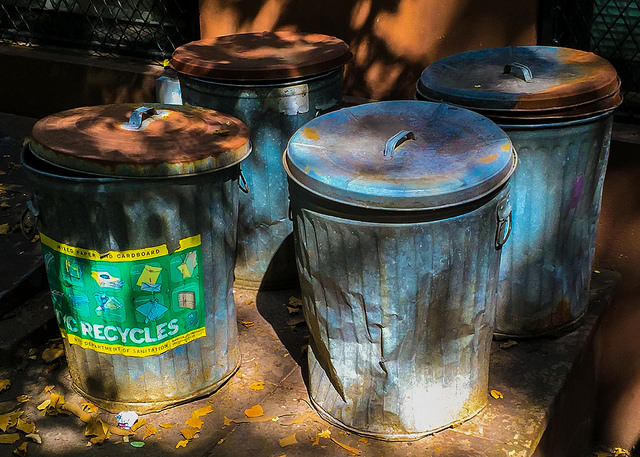There’s a lot to love about New York City in the summer. Eating, drinking and being outdoors helps makes the city come more alive and attractive at all hours of the day. Everything about the place seems brighter, bolder and generally better. But, one thing that is not better and, in fact, is far more offensive and intolerable is the resulting garbage.

Who put that there? (Source: mo1229 via Flickr Creative Commons)
Come summer in the city, there’s nothing like a whiff of sun-baked, rotting garbage to ruin an otherwise pleasant outdoor experience. What’s worse is that with all of summer’s outdoor activity, New Yorkers seem to generate more garbage, but are worse at dealing with it.
Head to any public park on a Monday morning after a busy summer weekend of BBQs and picnics and the place is two steps short of a dump. Trash cans are overflowing with leftover cakes, Slurpee cups and watermelon rinds. Residential streets can be just as bad as block parties and late-night stoop sessions often result in piles of empties, puddles of melted Popsicles and the remains of runaway hot dogs.

The overflowing trash can… a familiar NYC sight in the summer. (Source: Brian James via Flickr Creative Commons)
Although the profusion of garbage grosses out most New Yorkers, there is one subset of the local population who relish the stuff… rats. Garbage is the life blood of rats. Areas rich in garbage will also be rich in rats.
One recent New York Times Magazine article dubbed New York “the rat’s ideal habitat,” in part because our constant deluge of trash – especially in the summer – provides a steady source of food for the rodents. The next time you catch a fetid, sour scent in the area, just think to yourself it’s not just rotting trash you’re in close proximity to, but also rats. Yuck.

Disclaimer: New York City rats are NOT this cute. (Source: La Tarte au Citron via Flickr Creative Commons)
The city has taken a stand on the problem and built a task force to address the nearly two-million strong rat population. Since the Giuliani administration, there has been a three-day “rodent academy” to train public employees in rat-fighting tactics. Just this spring, a $2.9M budget to fight rats was passed and will foster the usage of rat-proof, solar-powered trash bins and support the rodent task force in identify rat-infested areas and rat breeding grounds.
The city-wide efforts hopefully will make an impact, but if you have rats in your garbage, in your building or on your block, don’t be passive. You, too, can be a rat vigilante. Here’s what you need to know.
Identify Rat-Friendly Environments
- Garbage! Rats love garbage. All those bags of garbage piled outside your apartment building or the bodega on the corner are the perfect breeding grounds for rats. Not only is garbage a source of food for rats, but when piled up it is also a place in which they can burrow and hide and procreate – sounds lovely, right?
- Clutter and debris of any kind. Are there storage boxes, bikes, sleds, stacks of newspapers and other bulky items stored outside your apartment building or in the basement? Get rid of them! These provide homes and reproduction areas for rats.

Clear away all clutter! (Source: Tina Sbrigato via Flickr Creative Commons)
Shrubs, brush and planters. Overgrown plants are another places rats love to hide and make their nests. While you may enjoy having big, bushy planters and shrubs to decorate the outdoor space around your building, keep in mind that rats enjoy these dark, weedy environments, too. Be wary of thick ivy, unkempt planters around trees and piles of dead leaves.
- Construction can help relocate rats closer to your home, too. If there is construction going on in your building or the surrounding building, you are more likely to have issues with rats.
- Schools, parks, subways, restaurants and delis all generate a lot of trash. Living near these types of places may increase your likelihood of having rats as neighbors.
Execute Rat Prevention Strategies
- Use metal trash cans with tight-fitting lids instead of plastic ones that rats can gnaw through.
- Put your trash in the can. Not next to it. Seems simple enough, right?
- Separate the organic waste from your regular trash – (i.e., compost)! Getting rid of the source of food that is attracting rats is a surefire way of addressing the issue.
- Put your trash out as close to trash pick-up time as possible. Avoid leaving your bags of trash out on the curb the night before the garbage truck comes.

Make sure the lids of your trash cans close properly. These don’t. (Source: Steven Pisano via Flickr Creative Commons)
Make sure your building’s trash room is clear of clutter, scattered garbage and is secured from rats entering. Be sure all entry points to the building’s trash room and basement are well sealed. Caulk is not enough. Rats can chew right through it. Go with cement, steel wool or a combination of the two.
- Wash the trash room or sidewalk around your building with a bleach-and-water solution. Rats can survive off the grease that oozes out of garbage bags so it’s important to remove that in addition to clearing away the trash itself. Washing down the sidewalk will remove evidence of rat pee and poop, which attracts other rats.
File a Complaint
Building owners in New York City are required to keep their property free of rats and rodents, so if you’re a renter than means the onus of managing extermination strategies falls to your landlord. If you own, that means the responsibility is yours. That said, even if you are a renter, be sure to follow the tips above to do your part in preventing rats.
If you suspect your building is under siege by rats, you can contact the New York City Department of Health and Mental Hygiene via 311 and file a complaint. The Department of Hygiene and Mental Health is charged with dealing with rodent infestation and will conduct an inspection of your property. Based on their findings, they will then determine if there are grounds for extermination or clean-ups at your property.
To learn more about how the city deals with rat infestations and their tips for prevention, check out this guide.
Related:










